IN THIS ISSUE
- Military-powered tortoises
- Finesse fire at Big Dukes
- Kindergarteners for nongame
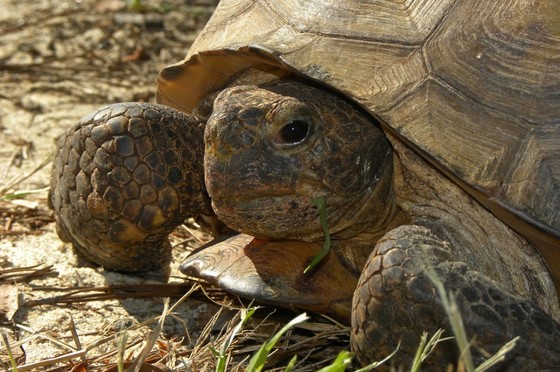 Gopher tortoise (Linda May/DNR)
Georgia's state reptile has the nation's military on its side.
A new Defense Department initiative including the U.S. Fish and Wildlife Service, Georgia DNR and others will help conserve gopher tortoises and preserve military training options in the Southeast.
Under the Department of Defense Conservation and Crediting Strategy signed last month, the military can earn credits for land acquisition, habitat restoration and other approved efforts to conserve gophers and their habitats on protected areas.
Those credits can be used to offset impacts from military training if the tortoise is federally listed in an area where the impacts occur. (The gopher is a candidate for Endangered Species Act listing in the eastern part of its range, which includes Georgia.)
The strategy is already having an impact. DNR acquired Alapaha River Wildlife Management Area last year with support from the U.S. Army and other partners. The 6,900-acre WMA east of Tifton has nearly 2,000 gopher tortoises – the highest number and greatest density on any state-owned tract.
Alapaha River WMA also has plenty of tortoise habitat and other at-risk species, such as gopher frogs, striped newts, eastern indigo snakes and pond spice.
DNR Wildlife Resources Division Director Rusty Garrison said during the signing event at ABAC that the strategy will help DNR meet its gopher conservation goals. A critical one is protecting 65 viable populations through acquisition or easements.
Alapaha River WMA is the first. All could help keep the tortoise off the federal list.
TORTOISE TIME
Join the Gopher Tortoise Council in celebrating April 10 as Gopher Tortoise Day!
Back to top.
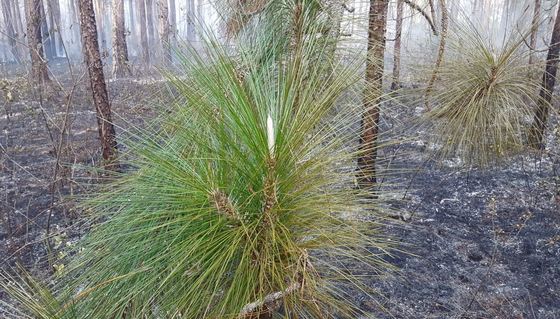 Young longleaf following Big Dukes burn (Lisa Kruse/DNR)
By LISA KRUSE
Prescribed fire is one of the most effective tools for conserving fire-adapted habitats and many wildlife species of concern that depend on those habitats.
But using fire requires intensive training and planning, and – like most work – benefits from experience.
Case in point: a recent burn at Big Dukes Wildlife Management Area by the Interagency Burn Team. The group includes DNR and represents years of experience restoring habitats with fire.
In 2004, DNR’s Nongame Conservation Section began restoring a pine plantation to longleaf pine forest in uplands at Big Dukes, near Millen. The plan: Mimic the natural regeneration of longleaf pine, where many trees germinate in small canopy openings created by disturbances such as wind or a tree falling.
Quarter-acre gaps were opened in the plantation. Longleaf were planted in the gaps. Needles falling from nearby trees provide tinder for fire to burn across the gaps and keep hardwoods from out-growing the young longleaf.
Yet burning these areas is a challenge. During a prescribed fire March 7, the Interagency Burn Team used careful ignition techniques to set a slow-moving, moderate fire in the gaps (watch the burn).
Staying low, the fire did what it was supposed to: spare new growth on short longleaf trees but move through hardwoods under the longleaf, killing the hardwoods.
This ability to finesse fire for targeted effects highlights the Interagency Burn Team’s deep experience. More than 10 years into the Big Dukes project, one result is young longleaf over-topping invading hardwoods and looking – as they should – like a natural patch of young trees in a longleaf forest.
Lisa Kruse is a botanist and prescribed fire practitioner with the Nongame Conservation Section.
FUEL FOR LEARNING
- 2016 fire review in Nongame Conservation Section report
- Georgia Prescribed Fire Council
Back to top.
 North Atlantic right whale (Cooper Hernandez/Winnona Park Elementary)
Kindergarteners at a Decatur school turned their attention to rare wildlife, and then turned that learning experience into support for Georgia’s Nongame Wildlife Conservation Fund.
Like other K-3 schools in the metro city, Winnona Park Elementary is an expeditionary school. In this model, core curriculum-based “expeditions” blend in-depth and interdisciplinary study of topics.
Last spring, part of Winnona Park’s science expedition for the five kindergarten classes explored rare species in Georgia, teacher Donna Fortenberry wrote.
Class choices included the North Atlantic right whale, Florida manatee, Appalachian cottontail and bats (a handful of species in the state are federally listed or considered of conservation concern). After studying wildlife, students studied illustrator Eric Carle and his collage-styled art, visiting the High Museum of Art to see his work.
Next, they put the knowledge to work. Each child painted tissue paper and cut and pasted dried pieces to create the class animal. As the project’s service component, samples of the art were printed on note cards and sold at the Celebration of Learning, a show-and-tell for parents that caps each expedition.
The school then sent a check for $1,784 in card sale “profits” to the Nongame Conservation Fund. Fortenberry wrote, “The students learned a great deal about endangered species, why they are endangered and what they can do to help organizations help these species.”
The contribution will help. So will the greater understanding of rare wildlife these students now share.
Back to top.
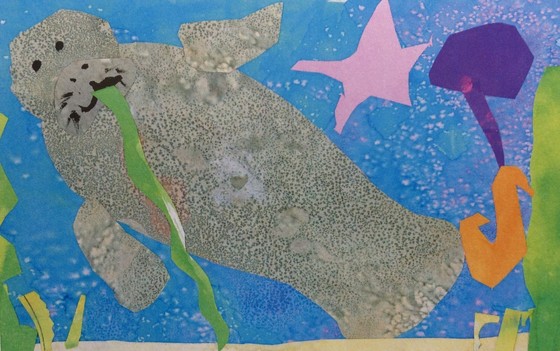 Florida manatee (Belle Rosendorf/Winnona Park Elementary)
WHAT YOU CAN DO
Contributing directly to the Georgia Nongame Wildlife Conservation Fund is easy and effective.
Simply contact the Nongame Conservation Section by email or phone (706-557-3303), or click for details. Donations are tax deductible to the extent allowed by law.
Direct donations and income from other non-fundraising sources made up 7 percent of the fund’s revenue in 2016. Remember that the Nongame Wildlife Conservation Fund is dedicated by law to conserving Georgia’s nongame and natural habitats.
Do like Winnona Park students did: Give wildlife a chance through direct giving.
How else to help
- If you haven’t filed your state taxes, contribute on your return to the Wildlife Conservation Fund (line 30 on Form 500 or 10 on Form 500-EZ). Every $1 helps.
- Buy or renew a DNR eagle or hummer license plate, the leading fundraiser for Georgia’s rare and other nongame animals, native plants and natural habitats.
- Learn more. See what your contributions support in our annual nongame report.
Back to top.
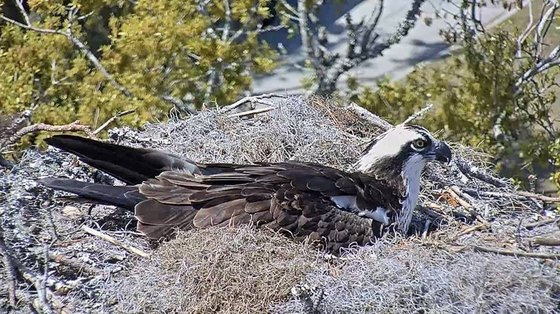 An osprey on the nest at The Landings
Ospreys at The Landings will be raising a family for all to see. As of Tuesday, there were two eggs in the nest live-streamed by the coastal community and used the previous two years by great-horned owls. Also watch at www.georgiawildlife.com.
Peregrine falcons nesting at Tallulah Gorge State Park have four eggs. While not online, the nest is in view of an overlook (the park offers loaner binoculars).
Atlanta’s peregrines will not be on camera this spring. As last year, the pair at SunTrust Plaza Tower is not nesting on one of the cam-accessible balconies.
Georgia legislators passed a bill that would, among other things, simplify Georgia's hunting and fishing license structure, raise license and boat registration fees closer to other Southeastern states and enable the state to recoup more federal excise taxes earmarked for wildlife programs. Georgia’s resident hunting and fishing license fees have not increased in a quarter-century.
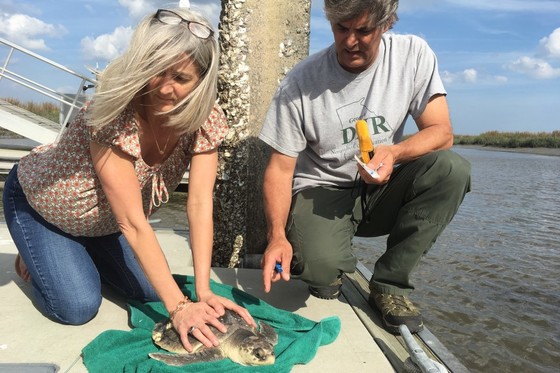 DNR's Tina Bennett and Mark Dodd assess Kemp's ridley (Ashley Raybould/DNR)
This young Kemps ridley sea turtle was accidentally caught during research work by DNR’s R/V Anna. Nongame Conservation Section staff assessed the healthy turtle, added a PIT tag and quickly released it.
The Florida or West Indian manatee has been federally down-listed from endangered to threatened. The U.S. Fish and Wildlife Service credits conservation efforts that resulted in population increases and habitat improvements.
Which county tag offices won in the wildlife license plates contest sponsored by The Environmental Resources Network? Cherokee posted the largest increase in tag sales and renewals October-December compared to 2016; Talbot, the largest percentage increase; and, Newton was the wild-card winner. Second and third in sales went to, respectively, Newton and Walker, and for renewals to Walker and McIntosh. TERN is Nongame Conservation Section’s friends group. Eagle and hummingbird tags are the No. 1 fundraiser for the agency, which depends mainly on fundraisers and grants.
The Outdoors GA app has been updated with more robust features, and all for free. Download the app at the Apple or Google Play Store (search "Outdoors GA”).
Alabama shad began migrating through Jim Woodruff Lock and Dam this month, moved through the lock just like boats. The passage is part of work to restore this species of concern to the Apalachicola-Chattahoochee-Flint River basin.
Back to top.
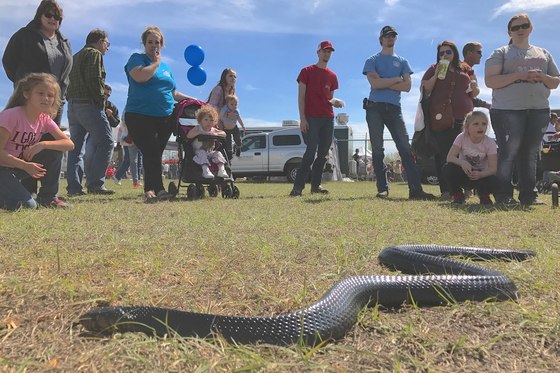 Eastern indigo at Claxton fest (Linda May/DNR)
If looking for rattlers, this eastern indigo snake is getting warm. The 50th annual Claxton Rattlesnake and Wildlife Festival drew thousands of people and scores of snakes (including DNR's "outreach" indigo) March 11-12.
DNR Forest Management staff planted hybrid American chestnut trees along Dawson Forest Wildlife Management Area’s “blue” hiking trail. The saplings are resistant to blight that wiped out mature chestnuts in the eastern U.S. by the 1950s.
Help clean up along the Flint River April 15 at a trash pick-up organized by Flint Riverkeeper and DNR senior wildlife biologist Nathan Klaus. The 8:30 a.m.-noon event focuses on land added to Sprewell Bluff Wildlife Management Area. Details.
Turkey hunters can help keep track of Georgia's wild turkey population by taking part in this annual DNR survey. The information is used to help determine production and population trends and guide management.
Correction: A link in the March 9 issue had a New York Times headline wrong. It should have read, “Amazon deforestation, once tamed, comes roaring back."
Back to top.
COMING UP
April 7 – Native Plant Botanical Garden plant sales, 10 a.m.-2 p.m., Georgia Perimeter College, Decatur. Also April 14-15, 21, 28-2, 9; May 5-6, 12, 19-20, 26-27.
April 7-8 – Chattahoochee Nature Center spring native plant sale, 10 a.m.-5 p.m., Roswell
April 11-13 –Public meetings on proposed 2017-18, 2018-19 Georgia hunting regulations, all at 7 p.m.: April 11, Go Fish Education Center, Perry; April 12, Forsyth Conference Center, Cumming; April 13, Sports Complex and Civic Center, Pearson.
April 15 – Volunteer trash pickup day with DNR, Flint Riverkeeper at Sprewell Bluff WMA, 8:30-a.m.-noon. Contact nathan.klaus@dnr.ga.gov.
April 14 -- Deadline for state-level entries in Georgia Give Wildlife a Chance Poster Contest, held by DNR and State Botanical Garden of Georgia
April 20-22 – Georgia Trail Summit, Columbus Convention & Trade Center, Columbus
April 22 -- Earth Day 2017 (including DNR nongame booth), 9 a.m.-2 p.m., Blue Heron Nature Preserve, Roswell
April 22 – Bird banding at Panola Mountain State Park, Stockbridge, 5:40 a.m. April 22, 5:20 a.m. May 13, 5:15 a.m. May 28, 5:10 a.m. June-August dates in upcoming issues. Contact Charlie Muise, Georgia Important Bird Areas Program.
April 26 – Sea Turtle Conservation Workshop and Cooperators Meeting, 8:30 a.m.-noon, DNR Coastal Regional Headquarters, Brunswick. Contact mark.dodd@dnr.ga.gov.
April 29-30 -- Youth Birding Competition.
June 3-8 and 17-22 -- Camp TALON (Teen Adventures in Learning Ornithology and Nature), two sessions, St. Simons Island (early registration with reduced fee until April 7; late registration April 8-May 5)
WHAT YOU MISSED
... in the last Georgia Wild:
- Tracking another golden eagle.
- Birds as weather forecasters.
- Okefenokee pygmy sunfish up close.
Back to top.
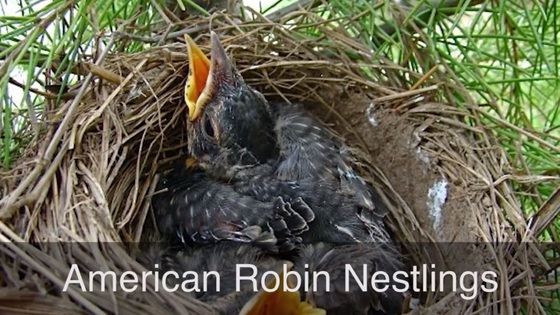 -- New Georgia Wild video exploring how to attract songbirds to your yard.
- Osprey fish delivery at The Landings nest cam.
- Copperhead snake’s first breath.
- Charlie Elliott Wildlife Center “Talking Nature Tuesday” on granite outcrops.
- Tadpole egg develops from four cells to millions (time-lapse video).
- Pool party of Allen’s hummingbirds.
- Badger buries calf carcass.
Back to top.
"Bald eagles thriving in Chatham County," Savannah Morning News
"Saving an endangered southern river (Conasauga)," U.S. Fish and Wildlife Service
"Right whale sightings sparse this year," South Carolina Coastal Resources blog. Also: The (Charleston, S.C.) Post and Courier.
"Disease continues its fatal sweep of bats (Black Diamond Tunnel, GA)," U.S. Fish and Wildlife Service
"Tax time can be good for Georgia wildlife," WLTZ-TV (NBC 38, Columbus)
"USDA seeks project proposals to protect and restore critical wetlands," USDA Natural Resources Conservation Service
"Keeping track of Georgia’s golden eagles," AJC.com (paywall)
"Invasive bushes in Decatur killing cedar waxwings," decaturish.com
"Be on the lookout for red-banded hairstreak," Backyard Wildlife Connection
"DNR Coyote Challenge begins," WXFG-TV (Fox 54, Augusta)
"10 weird ways you could be spreading invasive species," Cool Green Science
"Coastal programs face fears of deep budget cuts," Savannah Morning News
"Reefs and Rivers: The Altamaha’s connection to us (flow pattern study)," Georgia Southern University
"That’s a wrap for one weird Arctic winter," Arctic Deeply
Back to top.
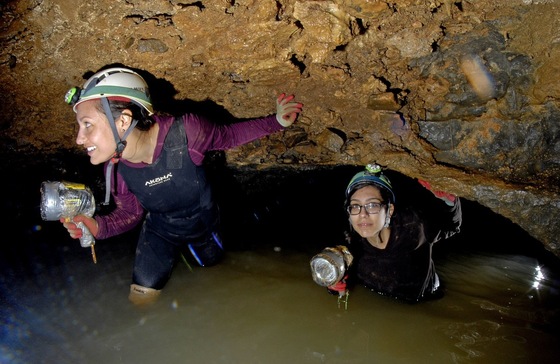 Surveying Anderson Spring Cave (Pete Pattavina/USFWS)
DNR technicians Leanne Burns, left, and Cindy Alcazar navigate a flooded passage in Pigeon Mountain’s Anderson Spring Cave while surveying for bats and white-nose syndrome. DNR and its partners recently completed winter surveys for white-nose. Meanwhile, updates from the Lone Star to the North Star State have been grim. Texas reported its first detection of WNS in late March, news that included the causative fungus Pd being found for the first time on cave myotis and a western subspecies of Townsend’s big-eared bat. Minnesota has documented the spread of WNS from one county in 2016 to six. Bat counts at affected sites declined 31-73 percent. White-nose is now confirmed in 30 states and five Canadian provinces, with Pd detected in three more states.
Masthead image: bat artwork (Rowan Stubbs, Winnona Park Elementary)
Back to top.
|